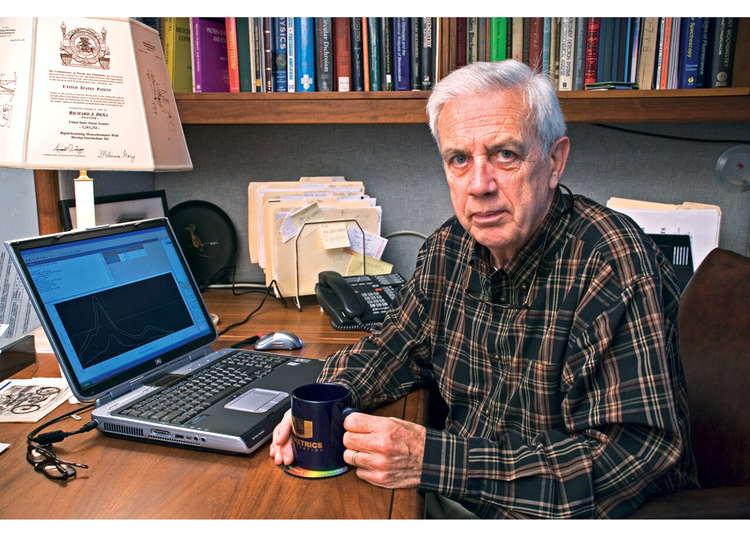The Facts About Uv/vis/nir Revealed
The Facts About Uv/vis/nir Revealed
Blog Article
What Does Circularly Polarized Luminescence Mean?
Table of ContentsThings about SpectrophotometersThe Facts About Spectrophotometers RevealedThe smart Trick of Circular Dichroism That Nobody is DiscussingThe Buzz on Circular DichroismHow Uv/vis/nir can Save You Time, Stress, and Money.

Spectrophotometry is a tool that hinges on the quantitative analysis of molecules depending on how much light is absorbed by colored compounds.
The Facts About Spectrophotometers Uncovered
A spectrophotometer is commonly used for the measurement of transmittance or reflectance of solutions, transparent or opaque solids, such as sleek glass, or gases. Many biochemicals are colored, as in, they soak up noticeable light and therefore can be determined by colorimetric treatments, even colorless biochemicals can typically be converted to colored compounds ideal for chromogenic color-forming responses to yield substances suitable for colorimetric analysis.: 65 Nevertheless, they can also be created to determine the diffusivity on any of the noted light varieties that typically cover around 2002500 nm utilizing various controls and calibrations.
An example of an experiment in which spectrophotometry is used is the determination of the balance constant of a solution. A specific chain reaction within a solution may happen in a forward and reverse instructions, where reactants form items and items break down into reactants. At some point, this chain reaction will reach a point of balance called an equilibrium point.
The smart Trick of Uv/vis That Nobody is Talking About
The amount of light that passes through the solution is indicative of the concentration of certain chemicals that do not permit light to pass through. The absorption of light is because of the interaction of light with the electronic and vibrational modes of particles. Each kind of molecule has an individual set of energy levels associated with the makeup of its chemical bonds and nuclei and thus will soak up light of particular wavelengths, or energies, resulting in special spectral homes.
Using spectrophotometers covers numerous clinical fields, such as physics, materials science, chemistry, biochemistry. UV/Vis/NIR, chemical engineering, and molecular biology. They are widely utilized in many markets including semiconductors, laser and optical manufacturing, printing and forensic assessment, as well as in labs for the study of chemical compounds. Spectrophotometry is often utilized in measurements of enzyme activities, decisions of protein concentrations, decisions of enzymatic kinetic constants, and measurements of ligand binding reactions.: 65 Eventually, a spectrophotometer has the ability to determine, depending on the control or calibration, what substances exist in a target and exactly just how much through calculations of observed wavelengths.
Created by Arnold O. Beckman in 1940 [], the spectrophotometer was created with the help of his coworkers at his company National Technical Laboratories established in 1935 which would become Beckman Instrument Business and ultimately Beckman Coulter. This would come as an option to the previously created spectrophotometers which were unable to absorb the ultraviolet correctly.
Spectrophotometers for Beginners
It would be found that this did not give satisfying results, for that reason in Model B, there was a shift from a glass to a quartz prism which permitted better absorbance outcomes - circularly polarized luminescence (http://go.bubbl.us/df2308/dba3?/New-Mind-Map). From there, Design C was born with a modification to the wavelength resolution which wound up having 3 systems of it produced
It was produced from 1941 to 1976 where the rate for it in 1941 was US$723 (far-UV devices were a choice at additional expense). In the words of Nobel chemistry laureate Bruce Merrifield, it was "most likely the most essential instrument ever developed towards the improvement of bioscience." Once Get the facts it ended up being stopped in 1976, Hewlett-Packard developed the first commercially offered diode-array spectrophotometer in 1979 understood as the HP 8450A. It irradiates the sample with polychromatic light which the sample takes in depending upon its homes. Then it is transmitted back by grating the photodiode range which discovers the wavelength region of the spectrum. Since then, the creation and application of spectrophotometry gadgets has increased exceptionally and has actually become one of the most innovative instruments of our time.

Circular Dichroism Can Be Fun For Everyone
Historically, spectrophotometers use a monochromator containing a diffraction grating to produce the analytical spectrum. The grating can either be movable or repaired. If a single detector, such as a photomultiplier tube or photodiode is used, the grating can be scanned step-by-step (scanning spectrophotometer) so that the detector can determine the light intensity at each wavelength (which will correspond to each "step").
In such systems, the grating is fixed and the intensity of each wavelength of light is determined by a different detector in the selection. In addition, most modern-day mid-infrared spectrophotometers utilize a Fourier transform method to acquire the spectral info - https://sketchfab.com/olisclarity1. This method is called Fourier change infrared spectroscopy. When making transmission measurements, the spectrophotometer quantitatively compares the fraction of light that travels through a referral service and a test service, then digitally compares the strengths of the 2 signals and calculates the percentage of transmission of the sample compared to the reference standard.

Report this page